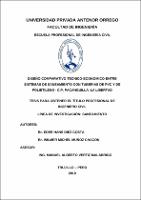Diseño comparativo técnico-económico entre sistemas de saneamiento con tuberías de pvc y de polietileno - C.P. pacanguilla - la libertad.

View/
Download
(application/pdf: 3.342Mb)
(application/pdf: 3.342Mb)
Date
2019Author(s)
Diez Costa, Eder Hans
Muñoz Chacón, Wilmer Michel
Metadata
Show full item recordAbstract
El estudio de las fugas de agua ha sido material de estudio en varias ocasiones
por diversos ingenieros, deben ser conscientes de la diferencia entre la cantidad
de agua que sale de una planta de tratamiento al Sistema de distribución y el
agua que es registrada en las viviendas de los usuarios por el medidor. Existen
perdidas en el uso del agua frecuente en cada hogar por lo que dentro del
Sistema lo llamaremos pérdidas de agua, el control de estas pérdidas es desde ya
un sobre costo importante para las empresas que dan el suministro de agua.
En Capítulo I se detallan los conocimientos previos de la investigación definiendo
los parámetros que están presentes en cada tesis y que estas ayudarán a
determinar los resultados requeridos.
En el Capítulo II se describe los tipos de materiales que van a intervenir en el
proyecto como son el PVC, polietileno y asbesto cemento, estos a su vez con
cada uno de sus respectivos accesorios, también se detallan las propiedades de
cada uno de estos.
Para el Capítulo III se definen los factores de influencia que deterioran las
tuberías, en otras palabras los parámetros que influyen en el decaimiento del
funcionamiento óptimo de la red.
En el Capítulo IV se describen los métodos de cálculo existentes y que nos
ayudarán en el procesamiento de la información de la red, a esto se suma el
criterio técnico del proyectista.
En el Capítulo V se evalúa la red existente definiendo todos sus componentes y el
estado actual de los mismos, además de realizar la cuantificación de las tuberías
y conexiones domiciliarias que al final es en lo que se centra la presente tesis.
En el Capítulo VI se define el procedimiento constructivo con cada tipo de
material, resaltando las diferencias entre uno y otra y tomando recomendaciones
de EPS como SEDAPAL y SEDALIB.
En el Capítulo VII se realiza el diseño hidráulico y se definen los resultados totales
del estudio de la presente tesis. Finalmente se colocan los anexos en donde se ubican cada uno de los cálculos
realizados para la presente tesis, teniendo en cuenta siempre la metodología y las
normas APA. The study of water leaks has been a study material on several occasions by
various engineers, they should be aware of the difference between the amount of
water that leaves a treatment plant to the distribution system and the water that is
registered in the homes of the users by the meter. There are losses in the use of
frequent water in each home, so within the system we will call it water losses, the
control of these losses is already an important cost for the companies that provide
the water supply.
In Chapter I, the prior knowledge of the research is detailed, defining the
parameters that are present in each thesis and which will help determine the
required results.
Chapter II describes the types of materials that will intervene in the project such as
PVC, polyethylene and asbestos cement, these in turn with each of their
respective accessories, also detailing the properties of each of these.
Chapter III defines the influence factors that deteriorate the pipes, in other words
the parameters that influence the decay of the optimal functioning of the network.
In Chapter IV the existing calculation methods are described and they will help us
in the processing of the information of the network, to this the technical criterion of
the designer is added.
In Chapter V, the existing network is evaluated by defining all its components and
their current status, in addition to quantifying the pipes and household connections
that this thesis focuses on in the end.
In Chapter VI the constructive procedure is defined with each type of material,
highlighting the differences between one and the other and taking EPS
recommendations such as SEDAPAL and SEDALIB.
In Chapter VII the hydraulic design is carried out and the total results of the study
of this thesis are defined.
Finally, the annexes are placed where each of the calculations made for this thesis
is located, always taking into account the methodology and the APA standards.
Collections
- Ingeniería Civil [1260]

